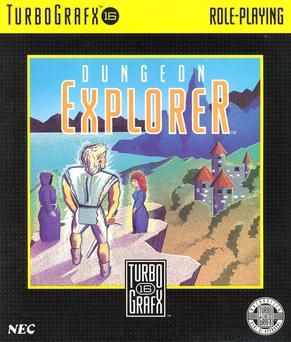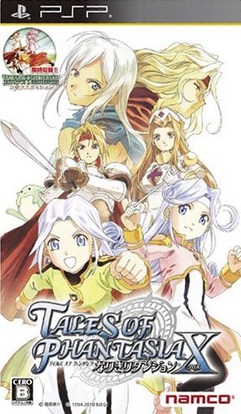
ChuChu Rocket! is a 1999 action puzzle game developed by Sonic Team and published by Sega for the Dreamcast. The objective is for the player to place arrows on a board to lead mice into escape rockets while avoiding cats. The game features single-player modes in which a player must save all the mice on a board, and a multiplayer mode in which players battle to collect the most mice.

Time Stalkers, also known as Climax Landers in Japan, is a role-playing video game for the Dreamcast featuring appearances of worlds from several of Climax Entertainment's earlier games in crossover fashion. The player initially takes the role of Sword, a character caught in a world made of many worlds. As he goes along, similar heroes show up for the player to control. The player may do things such as enter dungeons, take special assignments, and upgrade/buy/sell items.

Evolution 2: Far Off Promise is a role-playing video game for the Dreamcast console. It is a sequel to Evolution: The World of Sacred Device. It was developed by Sting and published by Ubi Soft in North America. In Japan it was published by ESP, while in Taiwan a Microsoft Windows version was published by Dysin Interactive Corp.

Star Ocean: The Second Story, known in Japan as Star Ocean: Second Story, is an action role-playing video game developed by tri-Ace and published by Enix for the PlayStation. It is the second game in the Star Ocean series and the first game in the series to be released outside Japan, arriving in North America in June 1999 and Europe in April 2000, by Sony Computer Entertainment. Taking place in a science fantasy universe, the story centers around a young man named Claude C. Kenny, a cadet from a space-faring Earth organization who is stranded on an undeveloped, medieval-level planet. There, he meets several companions and must stop a plot from an evil organization that spans multiple worlds before finding his way home. The game was the basis of manga and anime adaptations.

Evolution Worlds is a role-playing video game developed by Sting Entertainment for the GameCube. It was first published in Japan in 2002 by Entertainment Software Publishing and later by Ubisoft in North America and Europe. The game contains an abbreviated version of Evolution: The World of Sacred Device (1999) along with the full sequel Evolution 2: Far Off Promise (1999) on the same disc. Both games were originally released on the Sega Dreamcast.

Fire Emblem: The Sacred Stones is a tactical role-playing game developed by Intelligent Systems, and published by Nintendo for the Game Boy Advance handheld video game console in 2004 for Japan and 2005 in the West. It is the eighth entry in the Fire Emblem series, the second to be released outside Japan, and the third and final title to be developed for the Game Boy Advance after The Binding Blade and its prequel Fire Emblem.

Eureka Seven, known in Japan as Psalms of Planets Eureka Seven, is a 2005 Japanese anime series created by Bones. The series was directed by Tomoki Kyoda, with series composition by Dai Satō, character designs by Kenichi Yoshida and music by Naoki Satō. Eureka Seven tells the story of Renton Thurston and the outlaw group Gekkostate, his relationship with the enigmatic mecha pilot Eureka, and the mystery of the Coralians. The fifty-episode series aired on MBS between April 2005 and April 2006. It was licensed by Funimation in North America, Madman Entertainment in Australia and New Zealand and by Anime Limited in the United Kingdom for English home video releases.

Dungeon Explorer is an action role-playing video game developed by Atlus for the TurboGrafx-16 and originally published by Hudson Soft in Japan on March 4, 1989, and later in North America by NEC on November 15 of the same year. The first installment in the eponymous franchise, the game is set in the land of Oddesia, which has been overrun by an alien race and where players assume the role of one of eight main characters tasked with recovering the Ora stone to kill the alien king Natas. Co-directed by Kazutoshi Ueda and Yōsuke Niino, the title was created by most of the same team that would work on later several projects such as entries in the Megami Tensei series. Though it was initially launched for the TurboGrafx-16, it was later re-released through download services for various consoles.

Digimon Rumble Arena is a 2001 fighting video game developed and published by Bandai. It is part of a video game series connected to the Digimon franchise and showcases the titular creatures within the context of a fighting video game. The player controls one of several Digimon and engages in combat with other Digimon within a variety of settings. Apart from the central fighting gameplay, a trio of mini-games are available upon the single-player campaign's completion.

Tales of Mobile is the collective name of several mobile phone-based games, available only to Japanese NTT DoCoMo FOMA 900i cellphone users. The games often feature characters and story elements from the popular Tales role-playing video game series. As these games are offered as a download-only phone service in Japan, none of them have been made available outside Japan.
Mystery Dungeon, known in Japan as Fushigi no Dungeon, is a series of roguelike role-playing video games. Most were developed by Chunsoft, now Spike Chunsoft since the merging in 2012, and select games were developed by other companies with Chunsoft's permission. The series began when co–creator of Dragon Quest, Koichi Nakamura, was inspired by Seiichiro Nagahata's experience with Rogue, who is also a fellow developer from the company, and a desire to create an original series. It began on the Super Famicom, progressing to almost all of Nintendo's and Sony's home and handheld consoles, WonderSwan, Dreamcast, Windows, and mobile devices.

Pro Evolution Soccer 2, also known as World Soccer: Winning Eleven 6 outside of Europe, is the second installment of Konami's Pro Evolution Soccer football simulation video game series. The Japanese release was succeeded by an updated and improved version called World Soccer: Winning Eleven 6 Final Evolution.
Deep Dungeon (ディープダンジョン) is a series of role-playing video games developed by HummingBirdSoft. The first two installments were released on the Family Computer Disk System by Square's label Disk Original Group (DOG); the third one was released on the regular Family Computer by Square directly and the final one by Asmik.

Dungeon Explorer: Meiyaku no Tobira and Dungeon Explorer: Jashin no Ryōiki are a pair of action role-playing video game for the PlayStation Portable and Nintendo DS, respectively. Both games were localized and released as Dungeon Explorer: Warriors of Ancient Arts in the United States and as Dungeon Explorer in Europe. The games are related to the PC Engine game Dungeon Explorer. Both are action role-playing games. They feature wireless connectivity to allow multiple players to connect to each other, and Jashin no Ryouiki also allows for online play using Nintendo Wi-Fi Connection on the Nintendo DS.

Tales of Phantasia: Narikiri Dungeon X is a remake of the Game Boy Color role-playing video game, Tales of Phantasia: Narikiri Dungeon, for the PlayStation Portable developed by Namco Tales Studio and published by Namco Bandai Games. It was released in Japan on August 5, 2010. The original game was the first sequel in the Tales series, which normally does not have connected storylines. The story begins 205 years after the beginning of Tales of Phantasia. The game's theme song is Glass Flower and was sung by Hanako Oku.

The Ninja Warriors is a beat 'em up video game developed by Natsume for the Super Nintendo Entertainment System and published by Taito in Japan and North America in 1994 and by Titus in Europe in 1995. It is a follow-up to Taito's 1987 arcade game of the same title, and shares similar gameplay. The player can choose between playing as one of three ninja androids, each with different attributes and a unique set of moves including jumps, dashes, throws, and other attacks. The game was developed by the same team at Natsume that later developed Wild Guns (1994).

Freedom Wars is a 2014 action role-playing video game developed by Dimps and published by Sony Computer Entertainment for the PlayStation Vita. Set in the distant future where the majority of humankind is imprisoned in penal city-states known as Panopticons which wage war against one another, the game involves players cooperating to fight enemies and contribute towards their Panopticon. The game was one of the most successful first-party PlayStation Vita titles in Japan, achieving the second highest all-time opening sales for Vita software sold there.

Spike Chunsoft Co., Ltd. is a Japanese video game development and localization company specializing in role-playing video games, visual novels and adventure games. The company was founded in 1984 as Chunsoft Co., Ltd. and merged with Spike in 2012. It is owned by Dwango.

Gundam Evolution was an online first-person team shooter developed by Bandai Namco Online and published by Bandai Namco Entertainment. The game launched as part of the Gundam media franchise on Windows on September 21, 2022, and later released on PlayStation 4, PlayStation 5, Xbox One, and Xbox Series X/S on November 30.
















